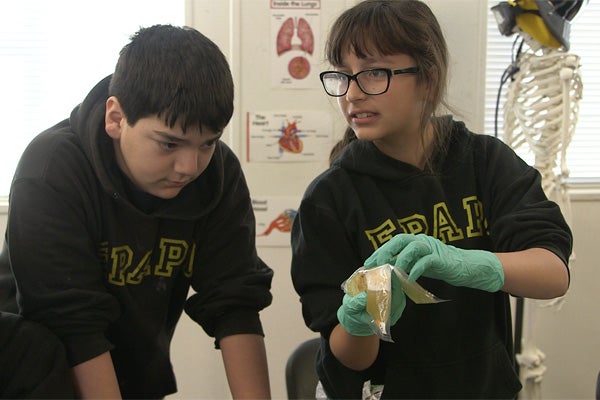|
View video here.
February 6, 2014
Grab your brains: Stanford students give local seventh graders a day to remember
Stanford graduate students take human and animal brains into middle schools in Palo Alto and East Palo Alto. By Amy Adams

Local middle-schoolers learn hands-on about brains from Stanford neuroscience students during Brain Day. (Photo: Kurt Hickman)
On Monday, Feb. 3, Stanford neuroscience students Ivan Millan and Sammy Katta got to the lab early. They grabbed some brains – both human and animal – and set out for East Palo Alto.
It was Brain Day. They had work to do.
Millan and Katta are among a group of graduate students who take brains to local middle school classrooms throughout Palo Alto and East Palo Alto as part of a program started by neurobiology Professor William Newsome more than two decades ago, when his own kids were in middle school.
The program started in a single school but has since grown to a monthlong series of classroom visits to 10 local schools.
The goal, however, remains the same: to get kids excited about science. And brains.
"These middle school students will be tomorrow's scientists who might answer the questions our institute has set out to study," said Newsome, who is the director of the Stanford Neurosciences Institute.
A day to remember
Veronica Woodard, who teaches biology to middle and high school students at East Palo Alto Phoenix Academy, energetically welcomed Katta and Millan. "It's my favorite day of the year," Woodard said. "Students get to see what we've been talking about in class. This solidifies the content I've been teaching."
It should be noted that Brain Day wouldn't be possible without people who donate their organs for research. At the start of class, Millan asked the students to be respectful of those who donated the brains they would be holding.
Then the fun began.
"It looks fake."
"It's light."
"They're kind of soft."
"It looks like plastic."
"It's wrinkly."
The human brains were all those things. In fact, before being preserved, the brains were even lighter and softer. And as for the wrinkles, they are part of what sets humans apart from other animals.
"Those wrinkles give more surface area for your brain to work," Millan said. Much like how a beach towel can be squeezed into a ball, the wrinkled human brain provides a larger surface for brain cells.
(Brains) of mice and men
At another table, Katta showed the students preserved brains from a variety of animals, including monkeys, rats, sheep, dogs and a turtle. Compared to human brains, the animal brains had a lot fewer wrinkles.
"Think about how smart the animals are and compare that to the size of the brain," Katta said. For animals with smaller, less wrinkly brains, thinking isn't their strength.
She also pointed out which part of the brain is responsible for smell. That region was small in the monkey brain, but much larger in that of the rat and the dog.
"You can tell what's important to an animal by looking at the brain," Katta said. "Dogs really like to smell."
Generating excitement
Katta says she likes volunteering for Brain Day because it helps get kids excited about science. "There are a lot of issues around us that involve science," she said. "I think this motivates kids to continue learning about science, and that knowledge and the skills they learn about how to think about the world around them are important regardless of what they do."
Woodard said the anticipation of seeing brains helps pique student interest in her lectures on the subject. "When I tell kids there's an opportunity for us to have brains in the classroom, the interest goes way up," she said.
And for some students, that interest really takes hold. Jordan Middle School teacher Terry Noeth received a letter from a former student heading to college to study physiology and neuroscience. The student wrote, "After adjusting to the awful smell of the brain slices, all I could think was: Woah. This strip of tissue used to be someone. This piece of brain used to think and love. I was so fascinated that I knew that when I grew up, I wanted to do something, anything, that related to the brain and how it makes us who we are."
-30-
|